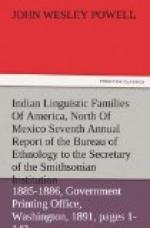GEOGRAPHIC DISTRIBUTION.
The center of distribution of the tribes of this family is generally considered to be the lower Colorado and Gila Valleys. At least this is the region where they attained their highest physical and mental development. With the exception of certain small areas possessed by Shoshonean tribes, Indians of Yuman stock occupied the Colorado River from its mouth as far up as Cataract Creek where dwell the Havasupai. Upon the Gila and its tributaries they extended as far east as the Tonto Basin. From this center they extended west to the Pacific and on the south throughout the peninsula of Lower California. The mission of San Luis Rey in California was, when established, in Yuman territory, and marks the northern limit of the family. More recently and at the present time this locality is in possession of Shoshonean tribes.
The island of Angel de la Guardia and Tiburon Island were occupied by tribes of the Yuman family, as also was a small section of Mexico lying on the gulf to the north of Guaymas.
PRINCIPAL TRIBES.
Cochimi.
Cocopa.
Cuchan or Yuma proper.
Diegueno.
Havasupai.
Maricopa.
Mohave.
Seri.
Waicuru.
Walapai.
Population.—The present population of these tribes, as given in Indian Affairs Report for 1889, and the U.S. Census Bulletin for 1890, is as follows:
Of the Yuma proper there are 997 in California attached to the Mission Agency and 291 at the San Carlos Agency in Arizona.
Mohave, 640 at the Colorado River Agency in Arizona; 791 under the San Carlos Agency; 400 in Arizona not under an agency.
Havasupai, 214 in Cosnino Canon, Arizona.
Walapai, 728 in Arizona, chiefly along the Colorado.
Diegueno, 555 under the Mission Agency, California.
Maricopa, 315 at the Pima Agency, Arizona.
The population of the Yuman tribes in Mexico and Lower California is unknown.
ZUNIAN FAMILY.
= Zuni, Turner in Pac. R. R. Rep., III, pt. 3, 55, 91-93, 1856 (finds no radical affinity between Zuni and Keres). Buschmann, Neu-Mexico, 254, 266, 276-278, 280-296, 302, 1858 (vocabs. and general references). Keane, App. Stanford’s Com. (Cent. and So. Am.), 479, 1878 ("a stock language"). Powell in Rocky Mountain Presbyterian, Nov., 1878 (includes Zuni, Las Nutrias, Ojo de Pescado). Gatschet in Mag. Am. Hist., 260, 1882.
= Zunian, Powell in Am. Nat., 604, August, 1880.
Derivation: From the Cochiti term Suinyi, said to mean “the people of the long nails,” referring to the surgeons of Zuni who always wear some of their nails very long (Cushing).
Turner was able to compare the Zuni language with the Keran, and his conclusion that they were entirely distinct has been fully substantiated. Turner had vocabularies collected by Lieut. Simpson and by Capt. Eaton, and also one collected by Lieut. Whipple.




